Application for Aircraft Maintenance Technician Position
Dear Hiring Manager,
I am writing to express my interest in the Aircraft Maintenance Technician position at [Company Name]. With over five years of hands-on experience in aircraft maintenance and safety inspections, I am confident in my ability to contribute effectively to your team. My certifications include FAA Airframe and Powerplant (A&P), and I have extensive experience with both commercial and private aircraft.
I am committed to ensuring the highest standards of safety and operational efficiency. I thrive in high-pressure environments and take pride in my meticulous attention to detail. I would welcome the opportunity to bring my expertise to [Company Name] and contribute to maintaining your fleet's excellence.
Thank you for considering my application. I look forward to the possibility of discussing how I can support your aviation operations.
Sincerely,
[Your Name]
Cover Letter for Aerospace Engineer Internship
Dear [Recipient Name],
I am excited to apply for the Aerospace Engineer Internship at [Company Name]. Currently pursuing a Bachelor’s degree in Aerospace Engineering, I have developed skills in CAD design, aerodynamic analysis, and propulsion systems. I am eager to gain practical experience and contribute to innovative projects within your team.
I am particularly impressed by [Company Name]’s work on [specific project or technology], and I am motivated to apply my academic knowledge to real-world aerospace challenges. I am enthusiastic, quick to learn, and dedicated to supporting your team’s objectives.
Thank you for your time and consideration. I hope to discuss how my skills and enthusiasm align with your internship program.
Best regards,
[Your Name]
Flight Operations Coordinator Cover Email
Hello [Hiring Manager Name],
I am writing to apply for the Flight Operations Coordinator role at [Company Name]. With three years of experience in airline operations, scheduling, and regulatory compliance, I have developed strong organizational and problem-solving skills that ensure efficient flight operations.
I enjoy coordinating teams, managing logistics, and optimizing schedules to maximize efficiency. I am confident that my hands-on experience and proactive approach will make me a valuable asset to your operations team.
Thank you for reviewing my application. I look forward to the opportunity to contribute to [Company Name]’s success.
Kind regards,
[Your Name]
Provisional Message for Aviation Job Inquiry
Hi [Recipient Name],
I hope this message finds you well. I am reaching out to inquire about potential openings in your aviation department. I have a background in aircraft maintenance and operational support and would be interested in exploring any suitable roles.
Could you please let me know if there are upcoming opportunities or if I can send my resume for consideration? I am eager to learn more about your team and how I might contribute.
Thank you for your time and assistance.
Best,
[Your Name]
Formal Letter for Pilot Job Application
Dear Recruitment Officer,
I am submitting my application for the Pilot position at [Airline/Company Name]. I hold an Airline Transport Pilot License (ATPL) with over 3,000 flight hours in both domestic and international operations. Safety, precision, and professionalism are the cornerstones of my career.
I am highly motivated to join [Company Name] and bring my expertise in flight planning, navigation, and crew coordination. I am confident that my dedication and experience align with your company’s standards for excellence.
I would be honored to discuss my application in further detail and provide references upon request.
Sincerely,
[Your Name]
What is a Cover Letter for Aviation and Aerospace Jobs and Why You Need It
A cover letter in aviation and aerospace is a formal or digital message that accompanies your resume when applying for positions within airlines, aircraft maintenance, aerospace engineering, or operational roles.
Its main purposes are:
- To introduce yourself and highlight your relevant skills.
- To explain your motivation for applying to a specific company or role.
- To demonstrate professionalism and communication skills.
- To complement your CV by providing context that resumes cannot fully capture.
It is essential because many hiring managers review cover letters to gauge enthusiasm, suitability, and fit for specialized aviation roles.
Who Should Send a Cover Letter in Aviation and Aerospace
- Job seekers applying for positions in aviation or aerospace, such as pilots, engineers, maintenance technicians, or operations staff.
- Recent graduates seeking internships in aerospace companies.
- Professionals requesting internal transfers or promotions within aviation organizations.
- Contractors or consultants offering specialized aerospace services.
The sender should always be the individual seeking employment or placement; letters from agents are usually only acceptable if explicitly requested.
Whom Should the Aviation Cover Letter Be Addressed To
- Direct hiring managers or HR personnel in aviation companies.
- Department heads or supervisors relevant to the position (e.g., Head of Maintenance, Chief Pilot).
- Recruitment agencies specializing in aviation and aerospace roles.
- Internship coordinators for student or graduate programs.
- If specific names are unknown, addressing the letter to "Hiring Manager" or "Recruitment Team" is acceptable.
When to Send a Cover Letter for Aviation Jobs
- Alongside your resume when applying for a new position.
- When requesting an internship or trainee position.
- During open recruitment drives or aviation job fairs.
- As a follow-up after meeting company representatives at career events.
- When responding to unsolicited opportunities or cold applications in aerospace companies.
How to Write and Send an Aviation Cover Letter
- Research the company and role to tailor the letter.
- Start with a professional greeting and state the position you are applying for.
- Highlight your relevant qualifications, experience, and certifications (e.g., FAA licenses, flight hours, CAD skills).
- Explain why you are interested in that specific company or project.
- Use a professional closing and include contact information.
- Send digitally via email or online application portals; print letters may be used for formal applications or recruitment fairs.
Requirements and Prerequisites Before Writing
- Updated and accurate resume or CV.
- Copies of relevant certifications or licenses.
- Knowledge of the company, its projects, and values.
- Understanding of the job role and required skills.
- Prepared references or recommendation letters if requested.
- Clear idea of your career objectives and how the role aligns with them.
Formatting Guidelines for Aviation and Aerospace Cover Letters
- Length: Typically 250–400 words.
- Tone: Professional, but can be enthusiastic or creative for internship roles.
- Style: Clear and concise; avoid jargon unless relevant to aerospace.
- Wording: Focus on achievements, qualifications, and motivation.
- Mode: Email for digital applications; printed letter for formal or official submissions.
- Etiquette: Polite, respectful, and tailored to the recipient.
After Sending the Cover Letter: Follow-up Steps
- Confirm receipt via email or portal if possible.
- Follow up after 1–2 weeks if no response has been received.
- Prepare for potential interviews or technical assessments.
- Keep copies of all correspondence for reference.
- Use the opportunity to network with company contacts or HR representatives.
Pros and Cons of Sending a Cover Letter in Aviation
Pros:
- Highlights your skills and experience more personally than a resume.
- Demonstrates enthusiasm and professionalism.
- Provides context for career gaps or transitions.
- Can set you apart from other candidates.
Cons:
- Time-consuming to tailor for each application.
- May not be read if the company prioritizes online applications or ATS systems.
- Poorly written letters can harm your chances more than sending none.
Tricks and Tips for Aviation Cover Letters
- Always mention relevant certifications or flight hours.
- Tailor each letter to the specific company and role.
- Keep sentences short and avoid overly technical jargon unless appropriate.
- Use active language and quantify achievements when possible.
- Proofread multiple times for grammar and clarity.
- Attach additional documents like logbooks, licenses, or project portfolios if relevant.
Common Mistakes to Avoid
- Sending generic, untargeted letters.
- Omitting essential certifications or licenses.
- Using overly casual language for professional positions.
- Writing excessively long letters.
- Failing to proofread, causing typos or formatting errors.
Elements and Structure of an Aviation Cover Letter
- Opening: State the position and greeting.
- Introduction: Briefly describe your background and motivation.
- Body: Highlight relevant skills, experiences, and achievements.
- Closing: Express enthusiasm, offer to provide references, and thank the reader.
- Attachments: Resume, certifications, licenses, or portfolios.
- Contact Information: Ensure it is clear and accessible.
Does It Require Attestation or Authorization?
- Typically, a standard application cover letter does not require attestation.
- Letters accompanying legal or regulatory submissions (e.g., security clearance applications or pilot license renewals) may require signatures or official endorsements.
- Always check company-specific guidelines or government requirements before submission.
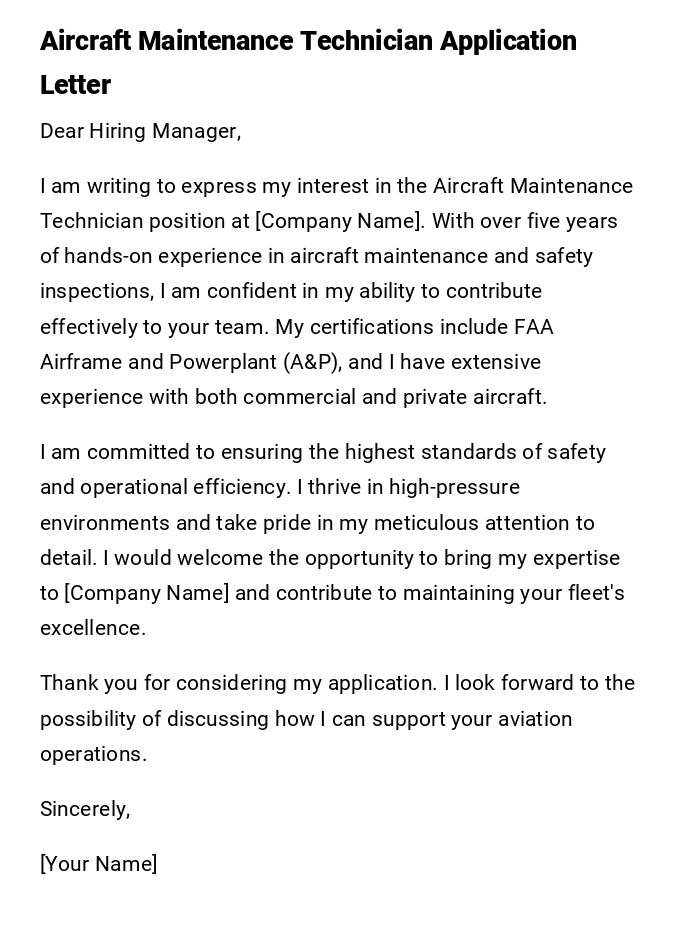
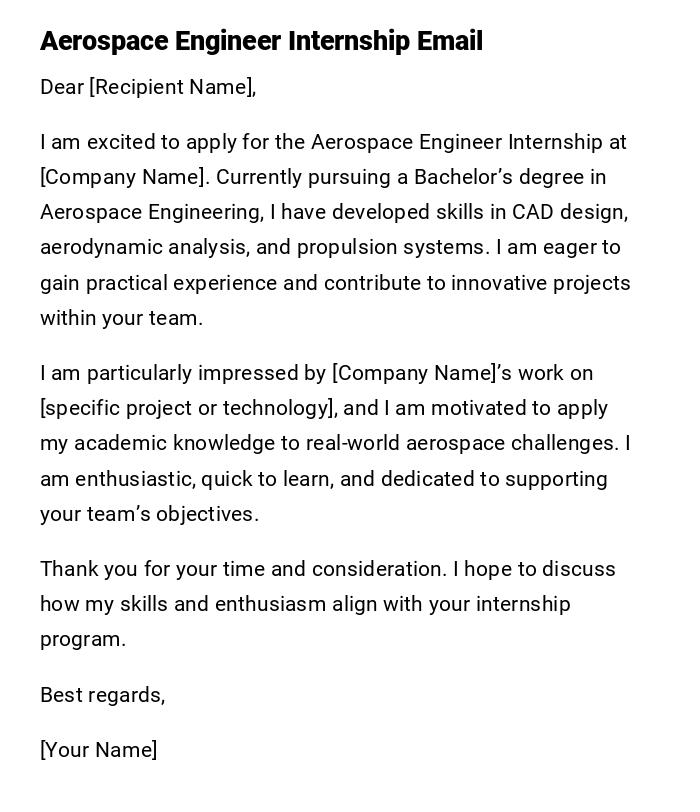
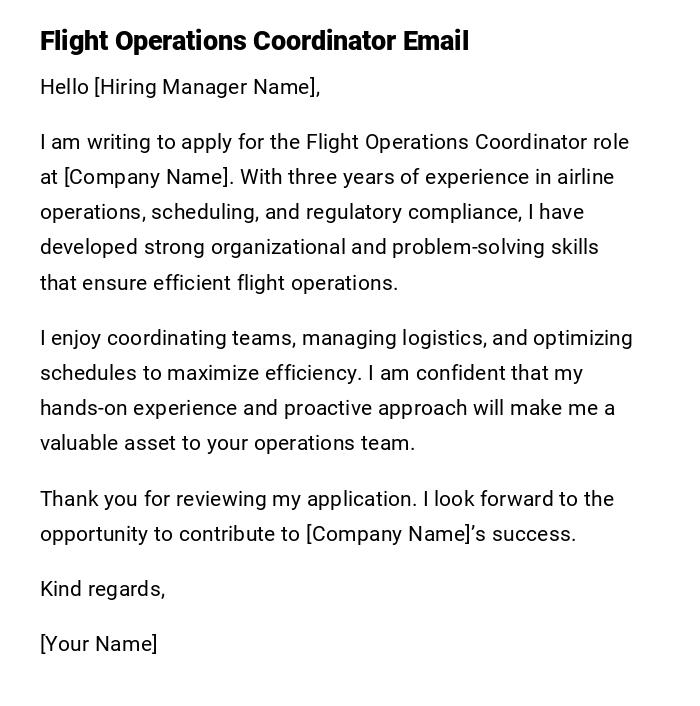
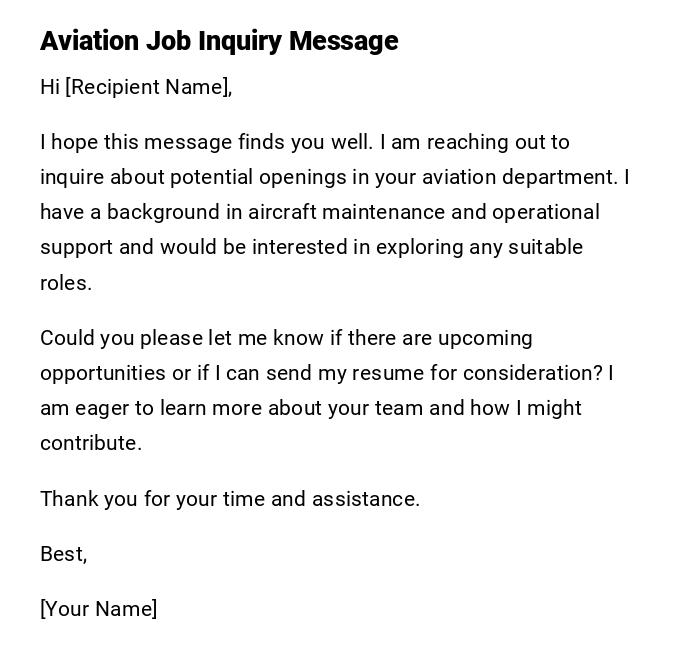
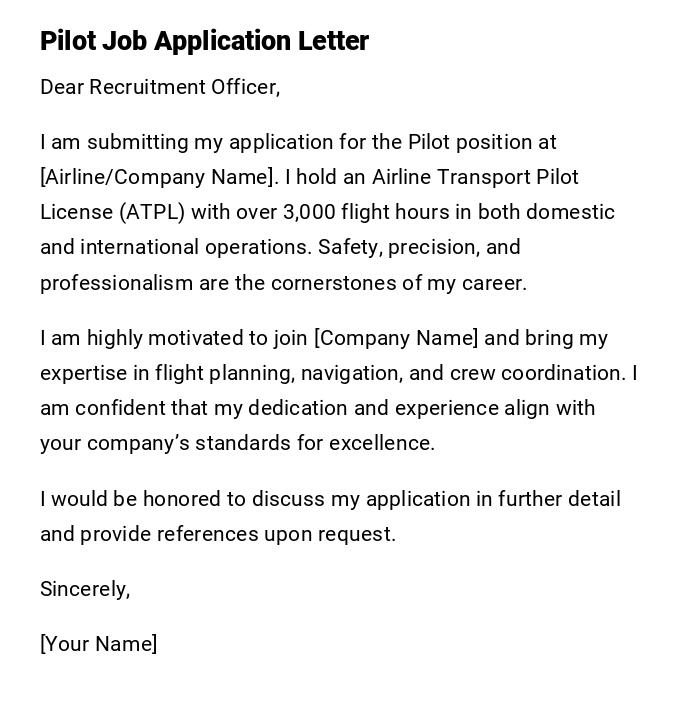

 Download Word Doc
Download Word Doc
 Download PDF
Download PDF